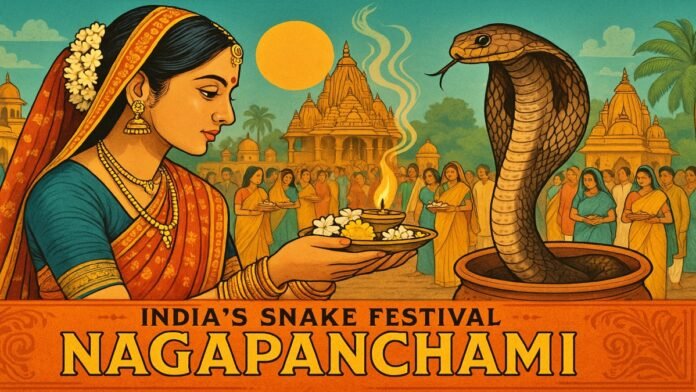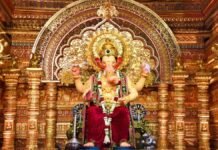
Key Points
- Nag Panchami celebrates the reverence of snakes (Nāgas) across India every monsoon, blending myth, nature, and spirituality.
- Major deities like Sheshnag, Vasuki, and Takshaka are worshiped for protection, fertility, and prosperity.
- The festival has roots in ancient legends involving Lord Shiva, Lord Krishna, and the Samudra Manthan.
- Linked to the monsoon, the rituals seek protection from snakebites and honor the balance of nature.
- Nag Panchami highlights the spiritual concepts of karma, rebirth, and Kundalini energy.
Nag Panchami, falling on July 30, 2025, is one of India’s most distinctive festivals, marked by the worship of snakes (Nāgas). This age-old tradition is a tapestry of mythological, cultural, agricultural, and spiritual beliefs:
1. Deep Mythological Significance
- Sheshnag & Vasuki: Revered in Hindu mythology, Sheshnag is the mighty serpent on whom Lord Vishnu reclines, while Vasuki played a critical role during the cosmic churning of the ocean (Samudra Manthan), symbolizing strength and cosmic balance.
- Lord Shiva: The snake coiled around Shiva’s neck signifies mastery over death, time, and primal force. Snake worship on Nag Panchami is often offered as homage to Shiva.
- Krishna & Kaliya: The tale of Krishna subduing the venomous Kaliya Nāga in the Yamuna symbolizes the victory of good over evil, highlighting serpent worship as a path to appeasing dangerous natural forces.
2. Agricultural Ties & Monsoon Traditions
- Protection During Monsoons: Nag Panchami falls in July-August, when snakes emerge due to flooding and farmlands are teeming with life. Farmers seek blessings to stay safe from snakes and protect their crops.
- Respect for Nature: Worshiping snakes is seen as essential for environmental harmony honoring creatures vital to the ecosystem, and asking for their benevolence.
3. Symbolism: Fertility, Energy, & Rebirth
- Kundalini Power: In yoga, the coiled serpent (Kundalini) at the spine’s base represents untapped spiritual energy. Snake worship is thus tied to spiritual awakening and regeneration.
- Regeneration: As snakes shed their skin, they embody transformation, fertility, and the endless cycles of renewal in both nature and life.
4. Traditions, Beliefs & Breaking Curses
- Pacifying Nāga Dosha: Many believe offending serpents brings Nāga dosha (serpent curse), believed to cause fertility issues or misfortune. Nag Panchami rituals are performed to appease the Nāgas and neutralize any ancestral or karmic curses.
- Generational Beliefs: Families carry forward rituals to ensure spiritual and physical protection for future generations.
5. Rituals & Practices
- Offerings: Devotees offer milk, flowers, turmeric, rice, and sweets to snake idols (made of clay, metal, or silver) at temples, anthills, or sacred groves.
- Mantras & Fasting: Special prayers and mantras like “Om Namah Sarpa Devaya Namah” are chanted, often accompanied by fasting.
- Modern Cautions: Due to wildlife laws, worship of live snakes is discouraged. The focus has shifted to symbolic rituals honoring serpent deities.
Major Serpent Deities Worshipped
- Ananta/Sheshnag: Infinite serpent of Lord Vishnu.
- Vasuki: Shiva’s companion during Samudra Manthan.
- Takshaka: Powerful serpent king from the Mahabharata.
- Karkotaka, Padma and others part of the ‘Ashta Nāgas’ or eight great snake deities.
Spiritual Essence
At its core, Nag Panchami reaffirms the sacredness of all life forms, the wisdom of coexisting with even the most fearsome creatures, and acceptance of divine energy in all of nature. The festival acts as a reminder that respect, not fear, sustains harmony with the world around us and within us.
On Nag Panchami, Hindus celebrate snakes as ancient keepers of wisdom and cosmic power, ensuring the festival endures as both a spiritual and ecological tradition in the heart of India’s monsoon.
Advertisement













































